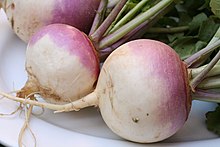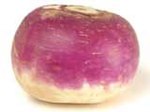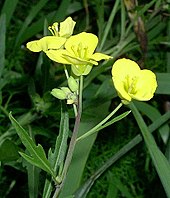| Turnip | |
|---|---|
 | |
| turnip roots | |
| Scientific classification | |
| Kingdom: | Plantae |
| (unranked): | Angiosperms |
| (unranked): | Eudicots |
| (unranked): | Rosids |
| Order: | Brassicales |
| Family: | Brassicaceae |
| Genus: | Brassica |
| Species: | B. rapa |
| Variety: | B. rapa var. rapa |
| Trinomial name | |
| Brassica rapa var. rapa L. | |
Contents
|
Description
The most common type of turnip is mostly white-skinned apart from the upper 1–6 centimeters, which protrude above the ground and are purple, red, or greenish wherever sunlight has fallen. This above-ground part develops from stem tissue, but is fused with the root. The interior flesh is entirely white. The entire root is roughly conical, but can be occasionally tomato-shaped, about 5–20 centimeters in diameter, and lacks side roots. The taproot (the normal root below the swollen storage root) is thin and 10 centimeters or more in length; it is trimmed off before marketing. The leaves grow directly from the above-ground shoulder of the root, with little or no visible crown or neck (as found in rutabagas).Turnip leaves are sometimes eaten as "turnip greens" ("turnip tops" in the UK), and they resemble mustard greens in flavor. Turnip greens are a common side dish in southeastern US cooking, primarily during late fall and winter. Smaller leaves are preferred; however, any bitter taste of larger leaves can be reduced by pouring off the water from initial boiling and replacing it with fresh water. Varieties specifically grown for the leaves resemble mustard greens more than those grown for the roots, with small or no storage roots. Varieties of B. rapa that have been developed only for use as leaves are called Chinese cabbage. Both leaves and root have a pungent flavor similar to raw cabbage or radishes that becomes mild after cooking.
Turnip roots weigh up to about one kilogram, although they can be harvested when smaller. Size is partly a function of variety and partly a function of the length of time the turnip has grown. Most very small turnips (also called baby turnips) are specialty varieties. These are only available when freshly harvested and do not keep well. Most baby turnips can be eaten whole, including their leaves. Baby turnips come in yellow-, orange-, and red-fleshed varieties as well as white-fleshed. Their flavor is mild, so they can be eaten raw in salads like radishes.
Nutrition
| Nutritional value per 100 g (3.5 oz) | |
|---|---|
| Energy | 84 kJ (20 kcal) |
| Carbohydrates | 4.4 g |
| Dietary fiber | 3.5 g |
| Fat | 0.2 g |
| Protein | 1.1 g |
| Vitamin A equiv. | 381 μg (42%) |
| Folate (Vit. B9) | 118 μg (30%) |
| Vitamin C | 27 mg (45%) |
| Vitamin K | 368 μg (350%) |
| Calcium | 137 mg (14%) |
| cooked, boiled, drained, without salt Percentages are relative to US recommendations for adults. Source: USDA Nutrient database | |
Origin
The turnip was a well-established crop in Hellenistic and Roman times, which leads to the assumption that it was brought into cultivation earlier. Sappho, the 7th century BC Greek poet, calls one of her paramours Gongýla, "turnip". Zohary and Hopf note, however, "there are almost no archaeological records available" to help determine its earlier history and domestication. Wild forms of the hot turnip and its relatives the mustards and radishes are found over west Asia and Europe, suggesting their domestication took place somewhere in that area. However Zohary and Hopf conclude, "Suggestions as to the origins of these plants are necessarily based on linguistic considerations."[1]Cultivation
The 1881 Household Cyclopedia gives these instructions for field cultivation of turnips:The benefits derived from turnip husbandry are of great magnitude; light soils are cultivated with profit and facility; abundance of food is provided for man and beast; the earth is turned to the uses for which it is physically calculated, and by being suitably cleaned with this preparatory crop, a bed is provided for grass seeds, wherein they flourish and prosper with greater vigor than after any other preparation.
The first ploughing is given immediately after harvest, or as soon as the wheat seed is finished, either in length or across the field, as circumstances may seem to require. In this state the ground remains till the oat seed is finished, when a second ploughing is given to it, usually in a contrary direction to the first. It is then repeatedly harrowed, often rolled between the harrowings and every particle of root-weeds carefully picked off with the hand; a third ploughing is then bestowed, and the other operations are repeated. In this stage, if the ground has not been very foul, the seed process.
The next part of the process is the sowing of the seed; this may be performed by drilling machines of different sizes and constructions, through all acting on the same principle. A machine drawn by a horse in a pair of shafts, sows two drills at a time and answers extremely well, where the ground is flat, and the drills properly made up. The weight of the machine ensures a regularity of sowing hardly to be gained by those of a different size and construction. From two to three pounds of seed are sown upon the acre (2 to 3 kg/hectare), though the smallest of these quantities will give many more plants in ordinary seasons than are necessary; but as the seed is not an expensive article the greater part of farmers incline to sow thick, which both provides against the danger of part of the seed perishing, and gives the young plants an advantage at the outset.
Turnips are sown from the beginning to the end of June, but the second and third weeks of the month are, by judicious farmers, accounted the most proper time. Some people have sown as early as May, and with advantage, but these early fields are apt to run to seed before winter, especially if the autumn be favorable to vegetation. As a general rule it may be laid down that the earliest sowings should be on the latest soils; plants on such soils are often long before they make any great progress, and, in the end, may be far behind those in other situations, which were much later sown. The hot turnip plant, indeed, does not thrive rapidly till its roots reach the dung, and the previous nourishment afforded them is often so scanty as to stunt them altogether before they get so far.
The first thing to be done in this process is to run a horse-hoe, called a scraper, along the intervals, keeping at such a distance from the young plants that they shall not be injured; this operation destroys all the annual weeds which have sprung up, and leaves the plants standing in regular stripes or rows. The hand hoeing then commences, by which the turnips are all singled out at a distance of from 8–12 inches, and the redundant ones drawn into the spaces between the rows. The singling out of the young plants is an operation of great importance, for an error committed in this process can hardly be afterward rectified. Boys and girls are always employed as hoers; but a steady and trusty man-servant is usually set over them to see that the work is properly executed.
In eight or ten days, or such a length of time as circumstances may require, a horse-hoe of a different construction from the scraper is used. This, in fact, is generally a small plough, of the same kind with that commonly wrought, but of smaller dimensions. By this implement, the earth is pared away from the sides of the drills, and a sort of new ridge formed in the middle of the former interval. The hand-hoers are again set to work, and every weed and superfluous turnip is cut up; afterward the horse-hoe is employed to separate the earth, which it formerly threw into the furrows, and lay it back to the sides of the drills. On dry lands this is done by the scraper, but where the least tendency to moisture prevails, the small plough is used, in order that the furrows may be perfectly cleaned out. This latter mode, indeed, is very generally practiced.
Human use
Pliny the Elder considered the turnip one of the most important vegetables of his day, rating it "directly after cereals or at all events after the bean, since its utility surpasses that of any other plant." Pliny praises it as a source of fodder for farm animals, and this vegetable is not particular about the type of soil it grows in and because it can be left in the ground until the next harvest, it "prevents the effects of famine" for humans (N.H. 18.34).
Carrot and Turnip output in 2005
In Turkey, particularly in the area near Adana, turnips are used to flavor şalgam, a juice made from purple carrots and spices served ice cold. In Middle Eastern countries such as Lebanon, turnips are pickled.
In Japan, pickled turnips are also popular and are sometimes stir fried with salt/soysauce.
Turnip lanterns are an old tradition; since inaugural Halloween festivals in Ireland and Scotland, turnips (rutabaga) have been carved out and used as candle lanterns.[2] At Samhain, candle lanterns carved from turnips — samhnag — were part of the traditional Celtic festival. Large turnips were hollowed out, carved with faces and placed in windows, used to ward off harmful spirits.[3] At Halloween in Scotland in 1895, masqueraders in disguise carried lanterns made out of scooped out turnips.[4]
Laurie Lee, in "Cider with Rosie", an autobiography of a childhood in the Cotswolds, mentions the Parochial Church Tea and Annual Entertainment, which took place around Twelfth night. "We...saw his red face lit like a hot turnip lamp as he crouched to stoke up the flames."
In Iran, boiled turnip roots (with salt) are a common household remedy for fever.
In the Punjab and Kashmir regions (India, Pakistan), turnips are used in variety of dishes. The most famous of these dishes is shab-daig.





No comments:
Post a Comment